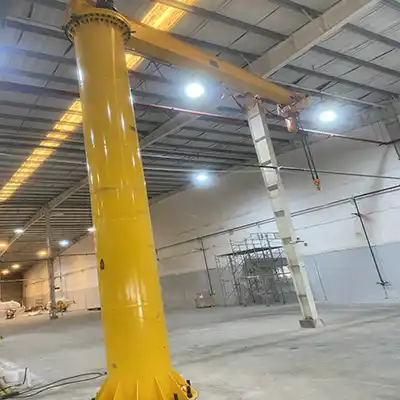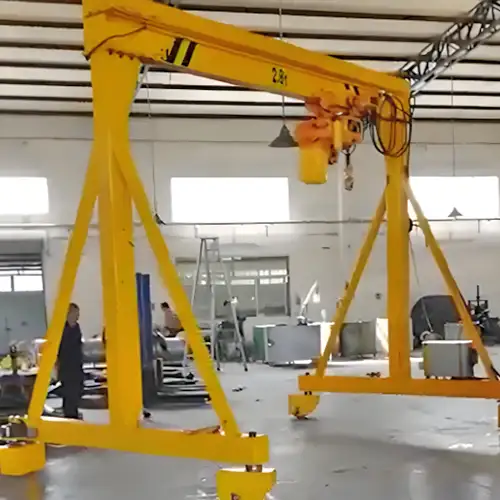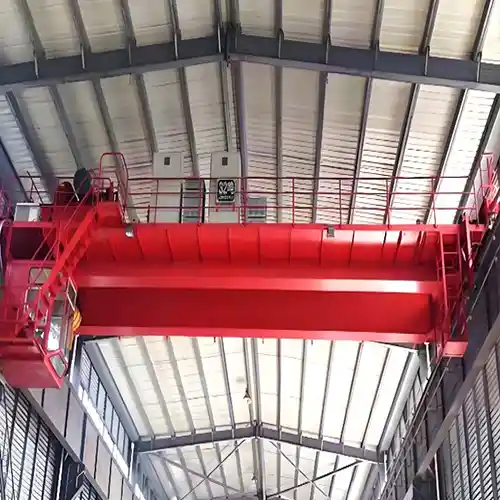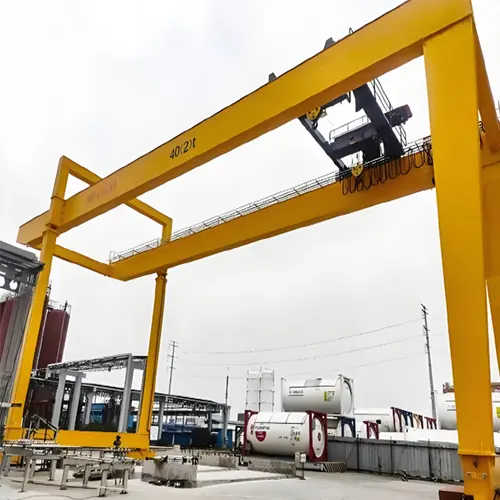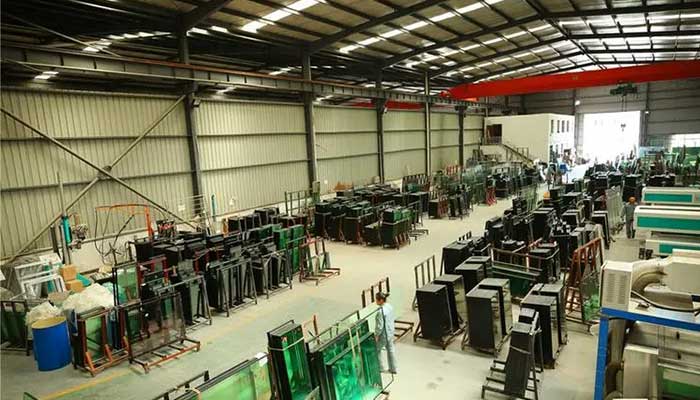
Bridge Overhead Cranes & Gantry Cranes in Window & Door Manufacturing
The window and door manufacturing industry is a cornerstone of modern construction and architecture, providing essential components that merge functionality, aesthetics, and innovation. From the elegant glass panels that invite natural light into spaces to the durable doors that safeguard security, the creation of these components is a complex and meticulous process that requires the perfect balance of precision, efficiency, and safety.
Overview of the Window and Door Manufacturing Sector:
In the intricate tapestry of construction and architecture, the window and door manufacturing sector stands as a vital thread. These components do more than just add visual appeal; they are integral to the functionality, insulation, and security of any structure. This industry encompasses a spectrum of materials, designs, and technologies that cater to a diverse range of needs, from residential homes to commercial spaces.
Windows serve as portals to the outside world, capturing views and bathing interiors in natural light. Doors are gateways that offer access, privacy, and security. The convergence of aesthetics and functionality in windows and doors requires a delicate balance, ensuring that the final products meet both practical and design-oriented expectations.
Importance of Overhead Cranes in Material Handling and Production:
As the window and door manufacturing industry evolves, so do the processes that bring these elements to life. Here, the stage is set for the entrance of a mechanical marvel: the overhead crane. Overhead cranes are indispensable tools that revolutionize material handling, production processes, and even the very way we construct our living and working spaces.
These bridge cranes offer a seamless solution to the challenges posed by the weight, size, and delicacy of window and door components. From heavy glass panels to intricate frames, overhead cranes facilitate the movement, positioning, and assembly of materials with unmatched precision. But their role extends beyond mere mechanical assistance; they embody the spirit of progress and innovation, shaping the window and door manufacturing landscape in profound ways.
In the upcoming sections of this series, we will embark on an in-depth exploration of the various types of overhead cranes used in the window and door industry, their unique features, functions, and tailored applications. From the controlled lifting of glass panels to the precise positioning of hardware, these cranes are the unsung heroes that elevate the art of window and door manufacturing to new heights.
Why Overhead Crane is Needed for Window and Door Manufacturing Industry
Overhead cranes are crucial in the window and door manufacturing industry for several reasons:
- 1. Handling Heavy Materials: Window and door components such as glass panels, frames, and hardware can be extremely heavy and bulky. Overhead cranes provide the lifting capacity necessary to move these materials safely and efficiently within the manufacturing facility.
- 2. Efficient Material Movement: Overhead cranes enable the rapid and precise movement of materials between different stages of the manufacturing process. This efficiency helps streamline production, reduce bottlenecks, and meet production deadlines.
- 3. Safety: Handling heavy materials manually can pose significant safety risks to workers. Overhead cranes eliminate the need for manual lifting, reducing the likelihood of injuries and strains caused by heavy lifting.
- 4. Precise Positioning: Window and door components require accurate positioning during manufacturing. Overhead cranes offer the ability to position materials precisely, ensuring that components are aligned and assembled correctly.
- 5. Optimal Space Utilization: The window and door industry often operates within limited space. Overhead cranes allow materials to be moved vertically, optimizing floor space and making room for other essential equipment and operations.
- 6. Assembly Line Support: Overhead cranes can be integrated into assembly line processes, allowing for the seamless movement of materials between different workstations. This integration contributes to efficient production flows.
- 7. Reduced Production Time: By enabling quick and efficient material handling, overhead cranes help reduce production cycle times. This can lead to increased output and faster delivery of finished products to customers.
- 8. Flexibility: Overhead cranes offer the flexibility to transport materials both horizontally and vertically. This adaptability is especially valuable when dealing with a diverse range of window and door components.
- 9. Less Labor-Intensive: Using overhead cranes reduces the need for manual labor in material handling tasks, freeing up workers to focus on more skilled and value-added aspects of production.
- 10. Consistency and Quality: Overhead cranes contribute to consistent and uniform handling of materials. This consistency helps maintain product quality and reduces the risk of damage to components during handling.
- 11. Reduced Risk of Material Damage: Delicate materials like glass can be easily damaged if mishandled. Overhead cranes offer a controlled and secure method of moving these materials, minimizing the risk of breakage or damage.
- 12. Enhanced Productivity: By providing a reliable means of material transport, overhead cranes boost overall productivity by eliminating time wasted on manual lifting and movement.
In summary, overhead cranes play a vital role in the window and door industry by providing efficient, safe, and precise material handling solutions. They contribute to improved productivity, reduced labor requirements, and enhanced product quality, ultimately benefiting both manufacturers and customers.
Types of Overhead Cranes Used in Window and Door Manufacturing
In the field of window and door manufacturing, precision is the cornerstone that ensures the seamless assembly of components into products that enhance our living and working spaces. One of the unsung heroes driving this precision is the diverse array of overhead cranes. These mechanical marvels elevate the movement, positioning, and assembly of window and door components to an art form. Let's delve into the fascinating realm of overhead cranes and their tailored applications in this industry.
In the window and door industry, several types of overhead cranes are preferred or frequently used to handle the specific needs of material movement, assembly, and production. The choice of overhead crane type depends on factors such as the size of the facility, the weight and size of the materials being handled, the layout of the production process, and safety considerations. Here are some common types of overhead cranes used in the window and door industry:
Bridge Cranes (Single Girder and Double Girder):
Bridge cranes consist of a horizontal beam (bridge) that spans between two end trucks, which travel along elevated runways. They are commonly used for heavy-duty lifting and material movement.
Bridge cranes are versatile and can cover a wide area, making them suitable for moving large window and door components within the manufacturing facility.
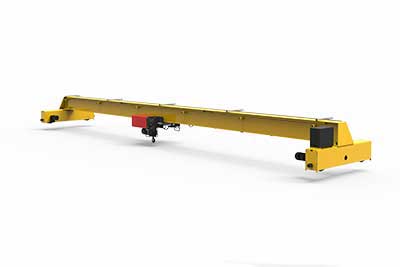
Single Girder Bridge Cranes 1 ton -20 ton : These cranes have a single girder supporting the bridge, making them more lightweight and cost-effective. They are suitable for moderate lifting capacities.
The single girder bridge crane stands as an embodiment of efficiency and versatility. Characterized by a single horizontal beam spanning between two end trucks, it effortlessly maneuvers across the production floor. With lifting capacities tailored to the needs of window and door manufacturing, this crane type shines in its ability to handle a wide range of components.
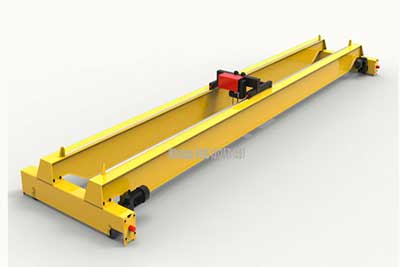
Double Girder Bridge Cranes 3 ton -80 ton : These cranes have two girders supporting the bridge, providing higher lifting capacities and more stability. They are used for handling heavier materials.
When the scale of manufacturing demands heavier lifting, the double girder bridge crane takes center stage. Boasting two horizontal beams for added stability and lifting capacity, this crane type tackles the weighty task of moving large glass panels, frames, and finished products with ease.
- Features: - High lifting capacity. - Span large distances within a facility. - Versatile for various materials.
- Benefits: - Efficient material handling and movement. - Reduced labor requirements. - Optimized floor space utilization.
- Functions: - Lifting and transporting heavy window and door components. - Moving materials between different production stations. - Loading and unloading materials from trucks.
- Typical Applications: - Glass panel handling and transport. - Frame assembly and movement. - Material storage and organization. - Loading and unloading materials from trucks.
Gantry Cranes:
Gantry cranes are similar to bridge cranes but are supported by legs that can be placed on the ground. They are often used in outdoor areas or locations where overhead runways are not feasible. Gantry cranes are ideal for lifting and transporting materials in open spaces, loading and unloading materials from trucks, and handling window and door components in areas without building structures.
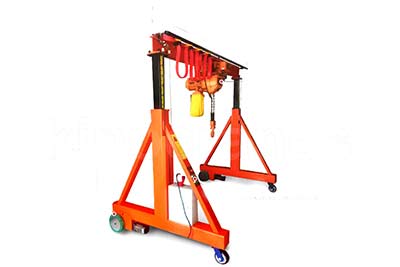
Mobile Gantry Cranes with Adjustable Height Design
In settings that require agility and adaptability, mobile gantry cranes emerge as the solution. These cranes feature wheels that allow them to traverse the production area. With a wide span and flexible lifting capacities, mobile gantry cranes effortlessly transport window and door components across the floor, streamlining the manufacturing process.

Fixed gantry cranes are a fixed point of strength in window and door manufacturing. Installed in dedicated workspaces, these cranes handle heavy components and materials with precision. Their stability and robust design make them ideal for tasks that demand controlled movement and precise positioning.
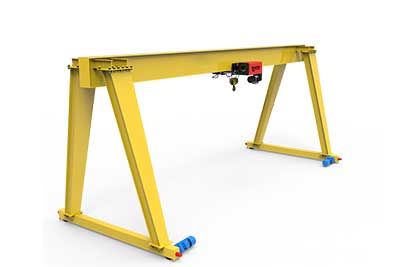
Single girder gantry crane 1 ton -10 ton
A single girder gantry crane 1- t0 ton has one beam that spans the gap between the legs of the crane. It is typically used for light to medium duty applications and has a lower cost compared to a double girder gantry crane. The single girder gantry cranes can be desgined into box girder & truss girder, full & semi gantry crane design.
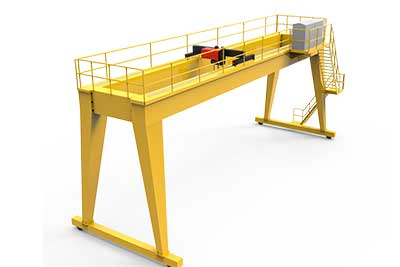
Double girder gantry crane 3 ton -320 ton
A double girder gantry crane 3 ton -320 ton has two beams that span the gap between the legs of the crane. It is used for heavy duty applications and can handle larger loads than a single girder gantry crane. However, it is more expensive than a single girder gantry crane. The double girder gantry cranes can be equippted with hoist and open winch for heavy loads handling.
- Features: - Suitable for outdoor and indoor use. - Freestanding structure with ground-mounted legs. - Versatile for various lifting requirements.
- Benefits: - Flexible placement in spaces without overhead structures. - Ideal for loading and unloading in outdoor areas. - Efficient material transport across open spaces.
- Functions: - Loading and unloading materials from trucks and outdoor storage. - Handling heavy materials in areas without overhead support. - Moving components within the manufacturing facility.
- Typical Applications: - Outdoor material handling and storage. - Loading and unloading truck shipments. - Transporting window and door components within the facility.
Jib Cranes:
Jib cranes consist of a horizontal arm (jib) that is mounted to a vertical support structure. They offer localized lifting and positioning, making them suitable for specific workstations. Jib cranes are commonly used for tasks such as moving glass panels or frames within a limited workspace, assembly of smaller components, and handling materials at specific points along the production line.
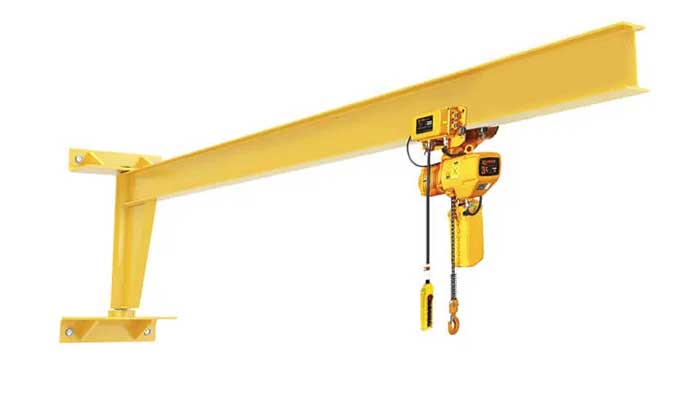
Wall-Mounted Jib Cranes 1 ton, 2 ton, 3 ton :
Wall-mounted jib cranes 1 ton, 2 ton, 3 ton are a testament to the art of localized material handling. These cranes feature a horizontal arm that projects from a vertical support structure attached to a wall. Ideal for tasks requiring precise positioning, they excel in moving glass panels, frames, and hardware within a confined workspace.
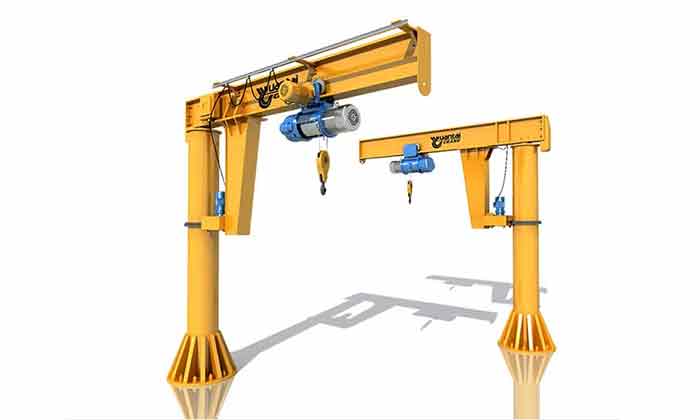
Free-Standing Jib Cranes 1 ton -16 ton :
For areas where wall mounting isn't feasible, free-standing jib cranes 1 ton, 2 ton, 3 ton, 5 ton, 10 ton, 16 ton emerge as the solution. Standing independently, these cranes offer a 360-degree reach, providing coverage across a designated area. They prove indispensable for tasks that demand flexibility in positioning and movement.
- Features: - Compact design for localized lifting. - Mounted on a vertical support pillar or wall. - Available in various configurations.
- Benefits: - Precise positioning of materials. - Efficient use of limited workspace. - Reduced risk of materials interfering with other processes.
- Functions: - Lifting and positioning materials at specific workstations. - Handling smaller components during assembly. - Supporting localized material movement.
- Typical Applications: - Moving glass panels within a limited workspace. - Positioning frames for assembly. - Handling small hardware and components at specific production points.
Each of these types of overhead cranes has its own advantages and best use cases in the window and door industry. Manufacturers often choose the type of overhead crane that best aligns with their production processes, facility layout, and material handling requirements. Additionally, modern overhead cranes can be equipped with advanced features such as remote control, automated positioning systems, and load monitoring for enhanced efficiency and safety.
Requirements for overhead cranes for window and door manufacturing industry
Window and door manufacturing has specific requirements for overhead cranes due to the unique characteristics of the materials being handled, the precision required in assembly, and the layout of the manufacturing process. Here are some special requirements for overhead cranes in the window and door manufacturing industry:
- 1. Gentle Handling of Fragile Materials: Many window and door components, such as glass panels, are fragile and can be easily damaged. Overhead cranes should be equipped with features that allow for gentle and controlled handling to prevent breakage.
- 2. Accurate Positioning: Window and door components need precise positioning during assembly to ensure proper fit and alignment. Overhead cranes should offer accurate control to position components exactly where needed.
- 3. Flexible Configuration: The dimensions and shapes of window and door components can vary significantly. Overhead cranes should be adaptable to different lifting configurations, including multiple attachment points or specialized lifting mechanisms.
- 4. Attachment Mechanisms: Cranes should provide suitable attachment mechanisms such as vacuum lifters, suction cups, or clamps that securely hold materials without causing damage.
- 5. Space Optimization: Window and door manufacturing facilities often have limited space. Overhead cranes should be designed to move materials efficiently within confined areas and avoid interfering with other processes.
- 6. Integration with Automation: As automation becomes more prevalent in manufacturing, overhead cranes should seamlessly integrate with automated systems for efficient material movement and assembly processes.
- 7. Clear Visibility: Operators need clear visibility when lifting and positioning components. The crane's design should minimize obstructed views to ensure safe and accurate operations.
- 8. Quick Changeovers: Window and door manufacturers often produce a variety of products. Overhead cranes should facilitate quick changeovers by providing easy adjustments for different lifting configurations.
- 9. Load Monitoring: Real-time load monitoring systems can prevent overloading and ensure that the crane operates within safe limits, particularly when handling heavy materials.
- 10. Safety Features: In addition to standard safety features, such as emergency stops and collision avoidance systems, overhead cranes in this industry might require additional features tailored to the specific challenges of handling large, flat, or delicate components.
- 11. Efficient Assembly Line Support: Overhead cranes should be able to support assembly line processes by efficiently moving components between workstations and stages of production.
- 12. Dust and Debris Resistance: Window and door manufacturing can produce dust and debris. Overhead cranes should be designed to resist the accumulation of these particles to maintain smooth operation and prevent contamination of components.
- 13. Customization: Manufacturers might require customized solutions to accommodate unique materials or production processes specific to their products.
- 14. User-Friendly Controls: Intuitive and user-friendly controls are essential for crane operators to ensure precise and safe material handling.
- 15. Maintenance Accessibility: Access to critical components for maintenance and servicing should be straightforward to minimize downtime.
- 16. Compliance with Industry Standards: Overhead cranes must meet industry safety standards and regulations to ensure worker safety and adherence to quality guidelines.
Meeting these special requirements ensures that overhead cranes effectively support window and door manufacturing, contributing to enhanced production efficiency, reduced material damage, and a safer work environment.
Capacity and Lifting Considerations: Precision Meets Power
In the field of window and door manufacturing, every component, from the delicate glass panels to the sturdy frames, plays a vital role in the final product's functionality and aesthetics. As we continue our exploration of the fascinating realm of overhead cranes, we turn our focus to a critical aspect: capacity and lifting considerations. The dance between precision and power forms the foundation of a flawlessly executed manufacturing process.
Determining Lifting Capacity Based on Window and Door Components
- Balancing Brawn and Finesse:The beauty of overhead cranes lies in their ability to handle a diverse range of materials, each with its unique weight and dimensions. In the window and door manufacturing industry, this diversity becomes an intricate dance between the crane's lifting capacity and the characteristics of the components it handles. Glass panels, frames, and hardware vary widely in mass, requiring overhead cranes to possess the strength to lift heavy loads while maintaining precision in positioning.
- Engineering the Perfect Lift:The process begins with a comprehensive analysis of the weight of each component involved in window and door manufacturing. Glass panels, often the heaviest elements, demand cranes with substantial lifting capabilities. Frames, on the other hand, vary based on materials, design, and size. By aligning the crane's lifting capacity with the weight of these components, manufacturers ensure smooth and safe material handling at every stage of production.
Factors Influencing the Choice of Appropriate Crane Capacity
- Weight of Components:The primary factor influencing crane capacity is the weight of the materials being handled. Glass panels, particularly those designed for large windows, can be substantial. Frames and hardware also contribute to the total load, and cranes must be equipped to manage these varying weights effectively.
- Size and Dimensions:The dimensions of the components play a significant role in determining the appropriate crane capacity. Oversized glass panels or frames may require cranes with higher lifting capabilities to ensure stable and precise movement.
- Safety and Control:Adequate crane capacity not only guarantees the safe lifting of materials but also ensures that the crane operates within its safety limits. Overloading a crane can compromise stability, endanger personnel, and damage materials, underscoring the importance of selecting the right crane for the job.
- Production Flow and Efficiency:An optimal crane capacity contributes to a seamless production process. Cranes that match the weight and dimensions of components reduce handling time, improve workflow, and enhance overall efficiency.
- Future Expansion and Versatility:Manufacturers must consider potential growth and changes in product lines. Investing in cranes with versatile lifting capacities accommodates evolving manufacturing requirements without the need for frequent crane replacements.
Features and Functions of Overhead Cranes in Window and Door Manufacturing
In the intricate dance of window and door manufacturing, precision and efficiency intertwine to craft components that are as functional as they are beautiful. As we continue our exploration of overhead cranes in this industry, we shine a spotlight on their remarkable features and functions. These mechanical wonders are not merely tools; they are orchestrators of precision, guardians of safety, and champions of progress.
Precise Positioning and Accuracy: Navigating the Fine Line
Artistry in Motion:Windows and doors are architectural pieces that demand meticulous positioning and alignment. Overhead cranes excel in this artistry, offering precise movement control that ensures components are positioned with impeccable accuracy. From placing glass panels onto frames to aligning hardware for seamless operation, the crane's role in achieving perfection cannot be overstated.
Material Protection and Gentle Handling: Crafting with Care
Handling the Delicate: -Glass panels and intricate frames demand gentle handling to prevent damage and ensure a flawless final product. Overhead cranes are equipped with mechanisms that offer a delicate touch, safeguarding the integrity of materials during lifting and movement. The marriage of strength and sensitivity ensures that even the most delicate components are handled with care.
Integration with Automation Systems: The Future Beckons
Embracing Automation: -As the window and door manufacturing industry embraces automation, overhead cranes play a pivotal role in this technological evolution. These cranes seamlessly integrate with automation systems, offering synchronized movement and positioning. Automation not only enhances precision but also streamlines the production process, reducing handling time and boosting efficiency.
Safety Features: Guardians of Security
- 1. Overload Protection: -The safety of personnel and materials is paramount. Overhead cranes are equipped with advanced systems that prevent overloading, ensuring that the crane operates within safe limits. This protection minimizes the risk of accidents and material damage.
- 2. Emergency Stops: -In case of unforeseen circumstances, emergency stops are a crucial feature. Overhead cranes are designed with readily accessible emergency stop buttons, allowing immediate halting of operations in critical situations.
Space Optimization and Adaptability: Crafting Space
- Space Efficiency: -Window and door manufacturing facilities often contend with limited space. Overhead cranes excel in optimizing vertical space, allowing materials to be stored and moved efficiently without consuming valuable floor area.
- Adaptability to Layouts: -From sprawling warehouses to compact workshops, overhead cranes adapt to various layouts, ensuring that every manufacturing environment benefits from their efficiency-enhancing capabilities.
Load Monitoring and Control Systems: Precision in Balance
- Balancing Act: -Overhead cranes are equipped with load monitoring systems that provide real-time feedback on the weight being lifted. This ensures that the crane operates within its safe capacity, contributing to the safety of both personnel and materials.
Energy Efficiency and Sustainable Practices: A Greener Tomorrow
- Towards Sustainability: -The window and door manufacturing industry is increasingly adopting sustainable practices. Overhead cranes join this movement by incorporating energy-efficient components and technologies, contributing to reduced energy consumption and a smaller environmental footprint.
Ease of Operation and User-Friendly Controls: Empowering Operators
- Operator-Centric Design: -Overhead cranes are designed with user-friendly controls that empower operators to maneuver components with ease and precision. Intuitive interfaces and ergonomic controls contribute to a seamless and efficient manufacturing process.
As we journey through the intricacies of overhead cranes in window and door manufacturing, we've explored their remarkable features and functions. But what truly brings these attributes to life is their application within the manufacturing process. Join us in Part 5 as we unravel the diverse range of scenarios where overhead cranes take center stage, orchestrating the creation of windows and doors with artful precision.

Single girder bridge overhead crane for window and door processing industry
Applications of Overhead Cranes in Different Procedures
In the field of window and door manufacturing, each procedure is a carefully orchestrated movement that contributes to the creation of functional and visually stunning components. As we continue our exploration of overhead cranes in this industry, we shift our focus to the captivating range of applications that these cranes undertake. From delicate glass handling to robust frame fabrication, overhead cranes conduct this orchestra of processes with precision and grace.
Glass Handling and Cutting: Crafting Transparency
- Precise Glass Handling: Glass panels, with their fragility and weight, demand a partner that understands their delicate nature. Overhead cranes delicately lift and transport glass sheets for cutting and shaping, ensuring accurate dimensions without risking breakage.
- Enabling Precision Cuts: Overhead cranes position glass panels with impeccable accuracy, facilitating the precise cuts required for customized windows and doors. The crane's controlled movements guarantee that the glass remains steady, allowing for intricate cuts that fit like puzzle pieces.
- Typical Overhead Crane: Bridge Crane (Single or Double Girder)
- Purpose:To lift and move large glass panels to cutting stations, providing precise positioning for cutting and shaping.
- Benefits:Accurate glass panel positioning, reduced manual handling, and improved safety.
Frame Fabrication and Welding: Forging Strength and Structure
- Lifting Frame Components: Frames form the backbone of windows and doors, and their fabrication requires lifting and transporting various components. Overhead cranes effortlessly manage these tasks, ensuring that frames are assembled with the right parts in the right sequence.
- Assisting Welding Operations: When frames are welded, precision is paramount. Overhead cranes position frame sections accurately, enabling welders to achieve consistent and strong joints. The crane's assistance in these intricate tasks contributes to the durability and stability of the final product.
- Typical Overhead Crane: Jib Crane or Bridge Crane
- Purpose: To move frame components, such as aluminum or wood pieces, to welding or assembly stations.
- Benefits: Efficient material movement, precise positioning for welding, and reduction in manual lifting.
Assembly and Glazing: Merging Form and Function
- Seamless Component Assembly: The assembly phase brings together the various elements of a window or door. Overhead cranes facilitate the smooth movement of components to their designated assembly points, reducing handling time and ensuring precise alignment.
- Gentle Glazing: The delicate act of attaching glass panels to frames demands a gentle touch. Overhead cranes, equipped with mechanisms to protect glass surfaces, ensure that glazing is achieved without scratches or damage.
- Typical Overhead Crane: Bridge Crane (Single or Double Girder)
- Purpose: To lift and position frame components and glass panels for assembly and glazing operations.
- Benefits: Accurate placement of glass and frames, optimized assembly line flow, and reduced risk of damage.
Hardware Installation: Precision in Every Detail
- Positioning Hardware: Hardware installation adds functionality and aesthetics to windows and doors. Overhead cranes position hardware components accurately, ensuring that handles, locks, hinges, and other details are affixed with precision.
- Alignment and Attachment: Intricate hardware components require careful alignment. Overhead cranes support this process, ensuring that hardware is attached accurately, contributing to the seamless operation of the final product.
- Typical Overhead Crane: Jib Crane or Bridge Crane
- Purpose: To transport and position hardware components such as locks, handles, and hinges for installation onto doors and windows.
- Benefits: Precise positioning of hardware, reduced manual labor, and enhanced assembly efficiency.
Finishing and Painting: Brushstrokes of Perfection
- Transporting for Finishing: After fabrication, frames may undergo finishing processes like painting or coating. Overhead cranes transport frames to finishing stations, enabling uniform application of finishes for an aesthetically pleasing result.
- Precision in Painting: Overhead cranes assist in positioning frames for painting, ensuring that every surface receives an even coat. This attention to detail elevates the visual appeal of windows and doors.
- Typical Overhead Crane: Bridge Crane (Single or Double Girder)
- Purpose: To move finished or partially assembled window and door units to painting or finishing stations.
- Benefits: Efficient material transport, reduced risk of damage during finishing, and improved production flow.
Quality Control and Testing: Ensuring Excellence
- Controlled Examination: Quality control is essential to ensuring that every window and door meets stringent standards. Overhead cranes aid in transporting components to quality control stations, allowing inspectors to thoroughly examine each element.
- Stress Testing: Certain components undergo stress testing to ensure their durability. Overhead cranes assist in positioning materials for these tests, contributing to the certification of robust and reliable products.
- Typical Overhead Crane: Jib Crane or Bridge Crane
- Purpose: To move completed window and door units to quality control and testing areas for inspections and assessments.
- Benefits: Accurate positioning for inspections, efficient movement between testing stations, and enhanced quality assurance.
Packaging and Shipping: Safeguarding the Journey
- Secure Packaging: Before reaching their final destination, windows and doors undergo careful packaging. Overhead cranes assist in packaging components securely, minimizing the risk of damage during transit.
- Efficient Loading: For products that leave the manufacturing facility, overhead cranes streamline the loading process, ensuring that windows and doors are placed onto transport vehicles efficiently and safely.
- Typical Overhead Crane: Bridge Crane (Single or Double Girder) or Gantry Crane
- Purpose: To lift and transport finished window and door units to packaging stations and loading areas for shipping.
- Benefits: Efficient material handling for packaging, reduced manual labor, and streamlined shipping processes.
Material Storage and Retrieval:
- Application: Storing raw materials and finished components in designated storage areas.
- Process: Overhead cranes lift and place materials onto storage racks or shelves.
- Benefit: Optimized space utilization, organized storage, and easy retrieval of materials.
Component Transport in Assembly Line:
- Application: Moving window and door components along the assembly line.
- Process: Overhead cranes transport materials between workstations for sequential assembly.
- Benefit: Smooth production flow, reduced handling time, and improved assembly efficiency.
Waste Removal:
- Application: Removing scrap materials and waste from production areas.
- Process: Overhead cranes lift waste materials and transport them to designated disposal areas.
- Benefit: Clean and organized work environment, efficient waste removal.
Different procedures in the window and door industry have unique requirements for material handling and positioning. The choice of overhead crane type depends on factors such as the weight and size of the components, the layout of the production area, and the need for precision. By utilizing the appropriate overhead crane for each procedure, manufacturers can optimize their processes, improve efficiency, and ensure the quality of the final products.

Double girder overhead bridge crane for general manufacturing
Benefits and Advantages of Overhead Cranes in Window and Door Manufacturing
As we journey through the intricate landscape of window and door manufacturing, the central role of overhead cranes becomes increasingly apparent. These mechanical marvels orchestrate a symphony of components, moving them with precision, protecting their integrity, and elevating the entire manufacturing process. In this chapter, we delve into the tangible benefits and advantages that overhead cranes bring to the world of windows and doors.
Enhanced Efficiency and Productivity
- Streamlined Workflow: Overhead cranes optimize material movement and positioning, reducing the time required for various procedures. Their ability to lift, transport, and place components with accuracy ensures that the manufacturing process flows seamlessly.
- Eliminating Bottlenecks: By efficiently transferring materials between workstations, overhead cranes prevent bottlenecks and delays in production. This results in a consistent workflow and enhanced overall efficiency.
Improved Worker Safety and Ergonomics
- Reducing Manual Handling: The weight and size of window and door components can pose physical risks to workers. Overhead cranes eliminate the need for manual lifting, reducing the chances of musculoskeletal injuries among employees.
- Ergonomic Handling: Overhead cranes are designed with operator comfort in mind. Ergonomic controls and intuitive interfaces ensure that operators can maneuver materials without strain or discomfort.
Reduction of Manual Labor and Material Damage
- Protecting Fragile Components: Glass panels and delicate frames are vulnerable to damage during handling. Overhead cranes employ specialized attachments and mechanisms to gently lift and transport materials, minimizing the risk of breakage.
- Minimizing Material Damage: Accidental drops and collisions can lead to material damage and waste. Overhead cranes offer precise movement control, ensuring that components are placed gently and accurately, reducing the chances of damage.
Contribution to Consistent Product Quality
- Precise Positioning: The accuracy of window and door components directly impacts their final quality. Overhead cranes position materials with impeccable precision, ensuring that components fit together seamlessly during assembly.
- Eliminating Human Error: Overhead cranes operate based on programmed commands, reducing the potential for human error in material handling. This consistency contributes to the uniformity and reliability of the final product.
As we unravel the myriad benefits and advantages of overhead cranes in window and door manufacturing, we witness their transformative impact on every facet of the process. From efficiency and safety to quality and consistency, these mechanical marvels elevate the artistry of creating windows and doors that not only adorn our spaces but also enhance their functionality. Join us in the final chapter of our journey as we explore the holistic picture of overhead cranes' role in this fascinating industry.
Benefits and Advantages: Tailored Overhead Bridge Cranes for Material Handling
As we traverse the captivating applications of overhead cranes in window and door manufacturing, the pivotal role of these mechanical marvels becomes evident. From precise glass handling to securing the journey of finished products, overhead cranes are the unseen conductors of this intricate manufacturing symphony. Join us in Part 6 as we uncover the tangible benefits and advantages that these cranes bring to the world of windows and doors.
In the intricate realm of window and door manufacturing, precision is the common thread that weaves together a harmonious final product. Yet, within this symphony of components, each piece requires a unique touch – a touch that overhead cranes provide through their tailored features and customization. As we delve deeper into the world of these mechanical marvels, we discover how they adapt to the specific needs of the industry, proving that flexibility and precision can indeed dance together.
Tailoring Overhead Cranes to Specific Needs
- Crafted for the Industry: The window and door manufacturing industry is a mosaic of intricate procedures and diverse materials. Overhead cranes are not one-size-fits-all entities; they are meticulously engineered to cater to the specific challenges and demands of this sector.
- Capacity and Reach: Depending on the size and weight of window and door components, overhead cranes can be customized to provide the optimal lifting capacity and reach. This ensures that every material is handled with the right combination of strength and precision.
- Space Constraints: Workspaces in window and door manufacturing facilities vary widely, from expansive warehouses to compact workshops. Overhead cranes are tailored to adapt seamlessly to these environments, optimizing space and ensuring efficient material flow.
Examples of Customized Attachments and Lifting Mechanisms
- Glass Handling Attachments: In the delicate dance of glass handling, overhead cranes can be equipped with specialized attachments that secure glass panels without risking breakage. Vacuum suction systems delicately grip glass surfaces, allowing for safe and accurate lifting.
- Adjustable Jib Crane Arms: For tasks that demand flexibility, such as frame assembly, jib crane arms can be customized with adjustable lengths. This ensures that materials can be lifted and positioned precisely, even in confined spaces.
- Ergonomic Controls: Operators are at the heart of crane operation. Customized control interfaces can be designed with ergonomics in mind, ensuring that operators can handle controls comfortably, minimizing fatigue during extended use.
- Load Monitoring Systems: Custom load monitoring systems provide real-time feedback on the weight being lifted, ensuring that cranes operate safely within their capacity limits. This added layer of safety enhances the overall manufacturing process.
- Integration with Automation: As automation continues to shape the manufacturing landscape, overhead cranes can be customized for seamless integration with automated systems. This enhances precision, reduces human error, and streamlines production.
Future Trends and Innovations in Overhead Cranes for Window and Door Manufacturing
As we approach the final act of our journey through the world of overhead cranes in window and door manufacturing, we cast our gaze towards the horizon of innovation. The landscape of manufacturing is ever-evolving, and overhead cranes are not exempt from the currents of change. In this chapter, we explore the exciting future trends and innovations that promise to shape the role of overhead cranes in this industry.
- Predictive Maintenance: Smart technologies enable predictive maintenance, where data analytics and AI predict when maintenance is needed. This proactive approach minimizes downtime and extends the lifespan of cranes.
- Remote Operation: Advancements in remote control technologies enable operators to control cranes from a safe distance. This is particularly beneficial for tasks that involve hazardous materials or environments.
- Automation Integration: Further integration of automation allows cranes to seamlessly interact with other manufacturing processes. Automated material handling and positioning optimize efficiency and reduce human intervention.
- Regenerative Braking Systems: Incorporating regenerative braking systems allows overhead cranes to convert braking energy into electricity, reducing overall energy consumption and contributing to sustainability.
- Energy Monitoring and Optimization: Smart systems that monitor energy usage in real-time enable operators to identify areas of inefficiency. This data-driven approach aids in optimizing crane operations for energy savings.
In this chapter, we've ventured into the future, where the art of overhead cranes evolves to meet the demands of an ever-changing manufacturing landscape. The integration of smart technologies, advancements in automation, and a commitment to sustainability promise a future where overhead cranes continue to be pivotal in creating windows and doors that reflect both innovation and excellence. Join us in the final part of our journey as we reflect on the entire symphony of overhead cranes' contributions to the window and door manufacturing industry.
Related sectors of windows and door industry
The window and door industry is closely related to several other industrial sectors due to its role in construction, building design, and architectural elements. Here are some related industrial sectors:
Construction Industry: The construction industry is a major partner of the window and door sector. Windows and doors are essential components of any building, and their design and installation are integrated into the construction process.
Construction Industry:
- Typical Types: Bridge Cranes, Gantry Cranes
- Capacity: Medium to heavy lifting capacities
- Features: High lifting heights, precise positioning, rugged construction
- Functions: Lifting and transporting construction materials, supporting construction processes
- Typical Applications: Moving steel beams, concrete panels, construction materials on-site
- Tailored Features: Outdoor durability, weather-resistant coatings, adaptability to construction site conditions
Building Materials Industry
Manufacturers of building materials, such as glass, aluminum, steel, wood, and plastics, provide the raw materials used in window and door production.
- Typical Types: Bridge Cranes, Gantry Cranes, Jib Cranes
- Capacity: Varied, depending on material weight and size
- Features: Material-specific lifting mechanisms, gentle handling options
- Functions: Loading and unloading raw materials, moving materials within warehouses
- Typical Applications: Moving glass sheets, steel beams, lumber, and other building materials
- Tailored Features: Specialized attachments for material handling, protection against material damage
Architectural Industry:
Architects and architectural firms work closely with window and door manufacturers to design structures that incorporate functional and aesthetically pleasing windows and doors.
- Typical Types: Jib Cranes, Bridge Cranes
- Capacity: Light to medium lifting capacities
- Features: Precision positioning, ergonomic controls
- Functions: Moving architectural components during design and assembly phases
- Typical Applications: Positioning models, prototypes, and large design elements
- Tailored Features: Compact design for limited spaces, aesthetic finishes
Furniture and Interior Design:
Windows and doors contribute to the interior design of buildings. Manufacturers in the furniture and interior design sectors may collaborate with window and door manufacturers to create harmonious interior spaces.
- Typical Types: Jib Cranes, Bridge Cranes
- Capacity: Light to medium lifting capacities
- Features: Gentle handling options, compact design
- Functions: Positioning furniture pieces, interior design elements
- Typical Applications: Moving decorative panels, fixtures, interior components
- Tailored Features: Soft lifting mechanisms to prevent damage to delicate components
Glass Industry:
Glass manufacturers supply the glass panels used in windows and doors. The window industry's demand for energy-efficient and specialized glass types drives innovation in the glass sector.
- Typical Types: Bridge Cranes, Gantry Cranes
- Capacity: Medium to heavy lifting capacities
- Features: Vacuum lifters, precision controls, anti-shatter safety measures
- Functions: Lifting and transporting glass sheets, panels, and products
- Typical Applications: Moving glass for cutting, tempering, and fabrication
- Tailored Features: Specially designed vacuum attachments for safe glass handling
Metal Fabrication Industry:
Manufacturers in the metal fabrication industry provide materials like aluminum and steel for window and door frames.
- Typical Types: Bridge Cranes, Gantry Cranes
- Capacity: Medium to heavy lifting capacities
- Features: Versatile lifting options, rugged construction
- Functions: Moving metal components, frames, and structures
- Typical Applications: Transporting steel beams, fabricated metal parts, welding materials
- Tailored Features: Customized lifting attachments for different metal shapes
Plastics Industry:
The plastics industry supplies materials used in window and door components such as weatherstripping, seals, and certain frame elements.
- Typical Types: Bridge Cranes, Jib Cranes
- Capacity: Light to medium lifting capacities
- Features: Material-specific lifting mechanisms, gentle handling options
- Functions: Moving plastic materials, molds, and components
- Typical Applications: Transporting plastic sheets, molds, finished plastic parts
- Tailored Features: Soft lifting attachments to prevent material deformation
Home Improvement and Renovation Industry:
Businesses in this sector provide replacement windows and doors for existing structures, contributing to energy efficiency and aesthetic upgrades.
- Typical Types: Bridge Cranes, Gantry Cranes
- Capacity: Light to medium lifting capacities
- Features: Precise positioning, adaptable to confined spaces
- Functions: Replacing and installing windows, doors, and related components
- Typical Applications: Handling replacement windows, doors, hardware during renovations
- Tailored Features: Compact design for residential spaces, user-friendly controls
Real Estate and Property Development:
The window and door industry impacts the property value and appeal of real estate developments, influencing the decisions of property developers and investors.
- Typical Types: Bridge Cranes, Gantry Cranes
- Capacity: Medium lifting capacities
- Features: Versatile lifting options, efficient material movement
- Functions: Transporting and installing window and door units in new constructions
- Typical Applications: Installing windows and doors in residential and commercial developments
- Tailored Features: High precision for accurate installations, adaptability to different building types
Energy Efficiency and Sustainability Industry:
Manufacturers that focus on energy-efficient solutions, insulation, and sustainable materials collaborate with the window and door industry to create eco-friendly and energy-saving products.
- Typical Types: Bridge Cranes, Gantry Cranes
- Capacity: Light to medium lifting capacities
- Features: Energy-efficient controls, sustainable materials
- Functions: Installing energy-efficient windows and doors, handling sustainable materials
- Typical Applications: Moving insulation materials, installing eco-friendly window and door units
- Tailored Features: Green technology integration, eco-friendly coatings
Smart Home Technology Industry:
As smart home technology advances, it's being integrated into windows and doors, allowing for automated opening, closing, and energy management.
- Typical Types: Bridge Cranes, Jib Cranes
- Capacity: Light to medium lifting capacities
- Features: Compatibility with automation systems, precise positioning
- Functions: Installing smart windows and doors, integrating automation technology
- Typical Applications: Positioning smart glass panels, automated window installations
- Tailored Features: Compatibility with IoT (Internet of Things) devices, remote operation
Safety and Security Industry:
Manufacturers in this sector contribute to the development of secure and impact-resistant windows and doors, important for both residential and commercial structures.
- Typical Types: Bridge Cranes, Gantry Cranes
- Capacity: Medium to heavy lifting capacities
- Features: Anti-vibration systems, secure load attachment
- Functions: Installing impact-resistant windows and security doors
- Typical Applications: Moving heavy security doors, impact-resistant glass panels
- Tailored Features: Enhanced safety mechanisms, secure attachment points
Facility Management and Maintenance Industry:
This sector is involved in the ongoing maintenance and repair of windows and doors in buildings.
- Typical Types: Jib Cranes, Bridge Cranes
- Capacity: Light to medium lifting capacities
- Features: Easy maintenance access, quick changeover
- Functions: Replacing or repairing windows, doors, and related components
- Typical Applications: Handling maintenance tasks, replacing damaged components
- Tailored Features: User-friendly controls, quick-change attachments
These related industrial sectors work in conjunction with the window and door industry to create functional, aesthetically pleasing, and sustainable building structures. Collaboration among these sectors drives innovation, quality, and improved performance in the construction and architectural domains.
Conclusion: The Elevating Force in Window and Door Manufacturing
As we reach the crescendo of our exploration into the world of overhead cranes in window and door manufacturing, we stand in awe of the pivotal role these mechanical marvels play. Like conductors leading an orchestra, overhead cranes choreograph the intricate movements, the precision, and the harmony that culminate in windows and doors that grace our homes, offices, and buildings. Let's reflect on the remarkable journey we've undertaken.
The Importance of Overhead Cranes
From the delicate handling of glass panels to the robust lifting of frames, overhead cranes are the guiding hands that ensure every component is positioned with meticulous accuracy. They transform complex procedures into orchestrated symphonies, streamlining processes that would otherwise be laden with manual labor and potential errors. The window and door manufacturing industry owes much of its efficiency, safety, and quality to these mechanical wonders.
The Triad of Streamlined Processes, Safety, and Quality
The partnership between overhead cranes and window and door manufacturing is not just a practical necessity; it's an artful collaboration that embodies precision and innovation. Overhead cranes are the bridge that connects efficiency with productivity, providing a seamless flow that eliminates bottlenecks and delays. They are the guardians of worker safety, ensuring that strenuous manual labor is replaced with precision-controlled movement.
In the realm of product quality, overhead cranes emerge as the keepers of consistency. The intricate dance of lifting and positioning materials results in components that align seamlessly during assembly. This commitment to precision extends to delicate glazing, secure hardware installation, and the flawless finishing touches that bring windows and doors to life.
The windows and doors that grace our living spaces tell stories of meticulous engineering, intricate craftsmanship, and artful collaboration. They bear the mark of overhead cranes, the elevating force that transforms materials into art, and buildings into homes.
